

To Become More Adaptable, Take a Lesson from Biology - Rafe Sagarin. By Rafe Sagarin | 12:30 PM March 5, 2013 Remember when Apple’s stock traded at $7 a share?

I do, because that’s when I sold my shares. Tech experts’ sage predictions had convinced me that the Mac would never make a dent in the PC market. As it turned out, the Mac didn’t need to make a dent, because Apple mutated its cute computer DNA into cute music players and phones that fit massive unfilled niches. Yet even the genius architect of this turnaround made faulty predictions sometimes.
Even the best of us are horrible at predicting the future. Fortunately, there’s a rich source of lessons on how to thrive in an unpredictable world, and it has been cranking out success stories for 3.5 billion years. All of Earth’s successful organisms have thrived without analyzing past crises or trying to predict the next one. Decentralization. JOURNEY OF MANKIND - The Peopling of the World.
Parsons The New School for Design. Filter by: Degree ∨ Filter by: Topics ∨ Filter by: School / Location ∨ Currently Displaying All Programs ADHT's undergraduate courses bring together all of Parsons' students to acquire the intellectual depth necessary to become leaders in their chosen fields.
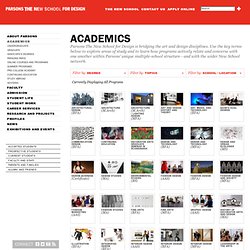
The school's research-driven graduate programs educate the next generation of theorists, writers, critics, historians, curators, and scholars. Shop.biomimicrygroup.com. David Henderson-Hean & Todd Brooks - FOCUS FORWARD. Learning from stinkbugs. Anchor On November 23rd, a biologist, an economist, a media theorist, a composer and a few other academics came here to Akademie Schloss Solitude to make a symposium on RhythmAnalysis.
The title references Henri Lefebvre's Rhythmanalysis: Space, Time and Everyday Life, but the presenters talked broadly about rhythm from their own disciplines. In the end it was up to us to make the connections back to everyday life and space as social practice. The presentation that offered me the most insight into re-thinking Space, Time, and Everyday Life came from a biologist who studies bugs, primarily stinkbugs. Meta Virant-Doberlet (Department of Entomology, National Institute of Biology, Ljubljana, Slovenia) records plant vibrations to study what she calls "substrate-borne communication. " Photo from Meta Virant-Doberlet via These stinkbugs use plants to transmit messages-- low frequency signals that vibrate within the substrate of the plant.
Arcology: Sustainable Hyperstructures: Jeff Stein at TEDxMission: TheCity2.0. Research. Biofacade Press Release. Grow your own home with ancient and modern tech. Tiffany O'Callaghan, CultureLab editor (Image: DPA/Press Association Images)
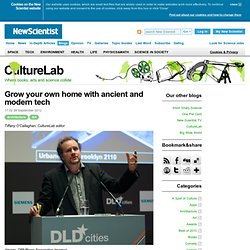
Featured Speaker: Mitchell Joachim - Events. Team:NYU Gallatin/ Van Alen Design Archive. Welcome to Van Alen Institute's Design Archive The Design Archive presents a unique selection of architectural drawings, photographs, and institutional records from over a century of design excellence at Van Alen Institute.

Zygote Quarterly. Bullfrog Films: 1-800-543-3764: Environmental DVDs and Educational DVDs. This two-part series is based on the acclaimed book, "Biomimicry: Innovation Inspired by Nature", by Janine Benyus.
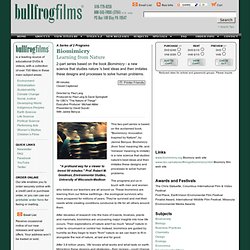
Biomimicry (from 'bios' meaning life, and 'mimesis' meaning to imitate) is a new science that studies nature's best ideas and then imitates these designs and processes to solve human problems. The programs put us in touch with men and women who believe our teachers are all around us. These biomimics are learning from our fellow earthlings - the ecological survivors who have prospered for millions of years. They've survived and met their needs while creating conditions conducive to life for all others around them. After decades of research into the lives of insects, bivalves, plants and mammals, biomimics are uncovering major insights into how life occurs. After 3.8 billion years, `life' knows what works and what lasts on earth.
The two programs introduce us to several scientists, businesspeople, and authors in this field. Transformative Designs. META-TECTONICA. Structuring Biomimicry, Improving Building’s Resiliency. The same way Einstein assumes the speed of light to be a constant of reference for his Theory of Relativity, the philosophy of biomimicry assumes Nature as a constant of reference to a performance-based beauty for design.
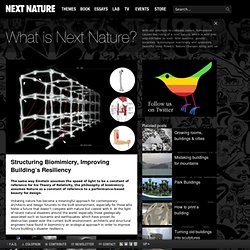
Imitating nature has become a meaningful approach for contemporary architects and design futurists to the built environment, especially for those who foster a future that doesn’t compete with nature but coexist with it. At the light of recent natural disasters around the world, especially those geologically associated such as tsunamis and earthquakes, which have proven its destruction power over the current built environment; architects and structural engineers have found in biomimicry an ecological approach in order to improve future building’s disaster resilience.
Present built structures are unresponsive to the Earth dynamics and aren’t completely adapted to the ecosystem flows of forces. Written by Wilfredo Mendez, M.Arch, AIT for IEET.org References: Master of Architecture. First of all hats offs for your blog and your desire to help students like us who are interested to know more about architecture.
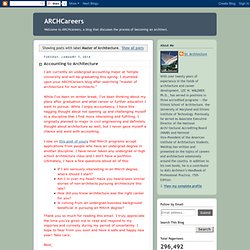
I did my civil engineering batch of 09-13 ,and I'm interesting in getting in to architecture and its allied industry .i have zeroed down two options a)first prof degree in architecture b) computational designer Right from childhood I was interested in arts, but always want to work at the intersection of mathematics and arts.i always use to think that science and arts are not two different things but after a certain level of abstraction u tend to find analogy in it. I'm confused which degree to get 1) do a first prof degree 3.5 years and then 1.5 years ms in CD , i cannot afford to study for 5.5 years as for each year i cannot afford 40k ,
Synthetic Biology & Architecture[1] CED - College of Environmental Design, UC Berkeley - Summer [IN]STITUTE in Environmental Design. Our six-week summer programs give students the opportunity to test their enthusiasm for the material and culture of environmental design.
![CED - College of Environmental Design, UC Berkeley - Summer [IN]STITUTE in Environmental Design](http://cdn.pearltrees.com/s/pic/th/stitute-environmental-berkeley-54657578)
Department of Architecture & Interior Design. What is a portfolio?
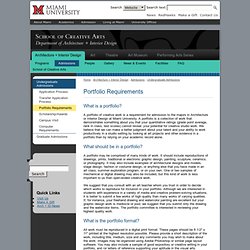
TOWARDS A BIOLOGICAL UNDERSTANDING OF ARCHITECTURE AND URBANISM: LESSONS FROM STEVEN PINKER., World Architecture Community. Biology and Architecture issue page, Biology and Architecture Architecture, Biology and Architecture in Architecture, Biology and Architecture articles, Architecture Theory and Issues, World Architecture Community Theory and Issues Page. Fab Tree Hab. In congruence with ecology as the guiding principal, this living home is designed to be nearly entirely edible so as to provide food to some organism at each stage of its life cycle.
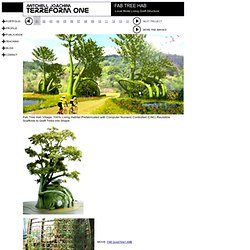
While inhabited, the home’s gardens and exterior walls continually produce nutrients for people and animals. As a positive contribution to the ecosystem it supports an economy comprised of truly breathing products not reconstituted or processed materials. Imagine a society based on slow farming trees for housing structure instead of the industrial manufacture of felled timber. The Fab Tree Hab presents a sophisticated methodology to grow homes from living native trees. This 100% living habitat is prefabricated using Computer Numeric Controlled (CNC) reusable scaffolding, manufactured off-site in advance. Prefabricated templates cut from 3D computer files control the early vegetative development.
Mitchell Joachim. Mitchell Joachim (pronounced /jo-ak-um/; born the same day as Alvar Aalto, February 3, 1972) is acknowledged as an innovator in ecological design, architecture, and urban design. Mitchell Joachim: Don't build your home, grow it! Rachel Armstrong: Architecture that repairs itself?